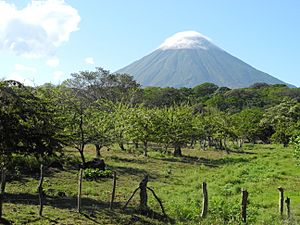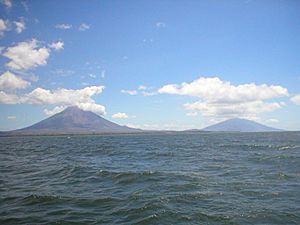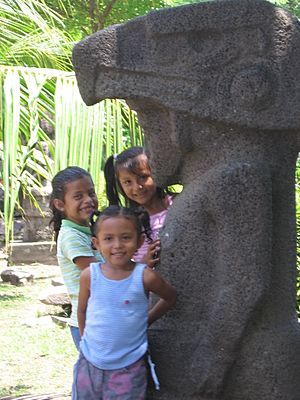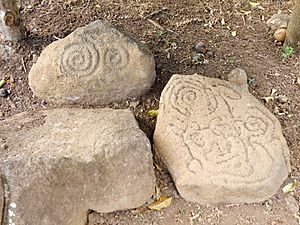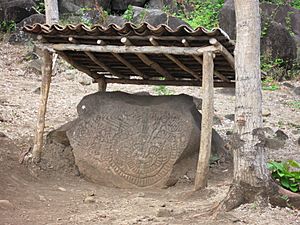Ometepe facts for kids
 |
|
| Geography | |
|---|---|
| Location | Lake Nicaragua (Lake Cocibolca) |
| Coordinates | 11°30′N 85°35′W / 11.500°N 85.583°W |
| Total islands | 1 |
| Major islands | 1 |
| Area | 276 km2 (107 sq mi) |
| Length | 31 km (19.3 mi) |
| Width | 10 km (6 mi) |
| Highest elevation | 1,610 m (5,280 ft) |
| Highest point | Concepción |
| Administration | |
| Department | Rivas |
| Largest settlement | Altagracia (pop. 4,081) |
| Demographics | |
| Population | 29,684 (June 2005) |
| Pop. density | 107.6 /km2 (278.7 /sq mi) |
Ometepe is a special island in Lake Nicaragua. It is made of two large volcanoes. These volcanoes rise right out of the water! The island is in the Rivas Department of Nicaragua.
The name Ometepe comes from old words. Ome means "two" and tepetl means "mountain". So, Ometepe means "two mountains". It is the biggest island in Lake Nicaragua.
The two volcanoes are called Concepción and Maderas. They are connected by a low strip of land. This forms one big island. Ometepe is about 276 square kilometers (107 sq mi) in size. It is 31 kilometers (19 mi) long. It is also between 5 to 10 kilometers (3 to 6 mi) wide.
People on Ometepe make a living from livestock (farm animals). They also do agriculture (farming) and tourism. Plantains are a very important crop grown here.
Contents
Who Lives on Ometepe Island?
People first lived on Ometepe a very long time ago. This was around 2000 BC to 500 BC. The first known people spoke Macro-Chibchan languages. You can still find signs of these early people. There are petroglyphs (rock carvings) and stone statues. These are on the northern slopes of the Maderas volcano. The oldest carvings are from 300 BC. Later, other groups like the Chorotega and Nicarao people added more carvings and statues. They carved these from basalt rock.
In the 16th century, Spaniards came to Central America. After this, pirates started sailing on Lake Nicaragua. They came from the Caribbean Sea using the San Juan River. The people of Ometepe had a hard time. Pirates stole their animals and food. They also kidnapped women. The pirates even built homes on the shore. This made people move higher up the volcanoes for safety. Spanish conquistadors finally settled the island in the late 1500s.
The main villages on the island are Altagracia and Moyogalpa. Altagracia has about 4,081 people. It is on the northeast side. Moyogalpa has about 2,905 people. It has a harbor on the northwest side. The island is split into two areas, each managed by one of these villages. People on Ometepe keep many old traditions alive. They celebrate more religious and folk festivals than other places in Nicaragua.
Today, Ometepe is growing in tourism and ecotourism. People love to visit for its history and beautiful nature. The island has amazing plants, animals, and birds. Ometepe Airport opened in 2014.
The Volcanoes of Ometepe
Concepción is on the northwest part of the island. It has a wide base, about 16 kilometers (10 mi) across. Its shape is very even and beautiful. This volcano is active, meaning it can erupt. Scientists believe it formed in the early Holocene period. It has erupted many times. Now, it is 1,610 meters (5,282 ft) tall. This makes Ometepe the world's highest lake island.
Concepción was quiet for a long time. Then, it erupted on December 8, 1880. This eruption was big and lasted a year. More eruptions happened in 1883, 1889, 1902, 1907, and 1924. In 2005, an earthquake happened. It was 6.2 on the Richter scale. This was because of pressure building inside the volcano. Roads on the island cracked. People were told to leave the island. This was the first small eruption since 1999. The most recent eruption was in 2010. It was very strong. But most people did not leave the island. Little damage was done.
The southeast part of the island has Maderas volcano. Maderas has a lake inside its crater. It is surrounded by a rich rainforest. Maderas also formed in the Holocene period. It rises 1,394 meters (4,573 ft) above sea level. People think Maderas is no longer active. The large lagoon in its crater was found in 1930. The sides of Maderas are mostly covered with coffee and tobacco farms. The rest is rainforest. Much of this area is now a nature reserve.
The volcanic ash from the volcanoes makes the soil very fertile. This means farmers can grow crops all the time. The volcanoes can be seen from everywhere on the island. Life on Ometepe is closely connected to them. They are also important in the island's old stories and legends. The island was once a burial ground for native people.
Ancient History and Archaeology
Ometepe Island is part of a larger archaeological area. This area is called "Greater Nicoya". It includes the Rivas area and goes into Costa Rica. The soil on Ometepe is very fertile. This is because of volcanic ash over thousands of years. This rich land allowed people to live here continuously. People have lived here since about 2000 BC. There was a special time called the "Ometepe period" (AD 1350 – 1550). During this time, the Nicarao people (who spoke Nahua) moved into the Greater Nicoya area.
Many archaeologists have studied the island. They include J.F. Bransford in the 1880s. Dr. Gordon Willey and Albert Norweb did excavations from 1959-1961. Wolfgang Haberland and Peter Schmidt worked there in 1962. Suzanne M. Baker led the Ometepe Petroglyph Project from 1995–1999.
Ancient Pottery
Dr. Gordon Willey and Albert Norweb dug at the Cruz site. This site is on the northeast part of the island. They found almost 30,000 pieces of pottery. Most of these were from the Late Polychrome Period. The pottery found helped define this period for the whole Rivas area. They also found pieces from an earlier time, the Zoned Bichrome Period.
One type of pottery found is "Ometepe Red Slipped-Incised". It is from the Late Polychrome Period. It is usually found as pieces of jars. This pottery is special because it is scraped smooth. It also has a dull red or brown color. Lines are cut into the jar's rim. Triangles are a common design. Other pottery types found include Granada Polychrome and Luna Ware Polychrome.
Rock Carvings (Petroglyphs)
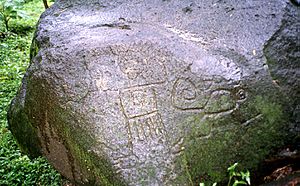
The Ometepe Petroglyph Project studied the Maderas side of the island. This was from 1995 to 1999. They surveyed 15 kilometers (9 mi) of the island. The project found 73 ancient sites. They mapped almost 1,700 petroglyph panels on 1,400 large rocks.
Almost all the sites had petroglyphs. Many of the carvings on Ometepe show spirals. They often "meander" across the rock. Stylized turtles are also a common design.
Some petroglyphs on Ometepe are very unique. Some human figures have "bowling ball faces". Spirals are used in different ways. Two spirals joined together might show the island itself, with its two volcanoes. Spirals are also used for the heads of human-like figures. Some figures look like ancient Mesoamerican drawings of Nagual. This suggests shared spiritual beliefs.
Other unusual carvings include seats or steps cut into rocks. There are also ovals and big grooves. The reason for these shapes is still a mystery.
In 1995 and 1996, ten sites were recorded. The most carvings were found at N-RIO-3. This site has 82 rocks with petroglyphs. It also has mortars, metates (grinding stones), and pottery pieces. In 1997, the project grew. Twenty volunteers helped record fifteen more sites. One impressive site, N-RIO-19, was very large. It had 92 petroglyphs, over 30 house mounds, stone statues, and pottery.
The Ometepe Petroglyph project used modern tools. They took many photos of each site. They used computer programs like Photoshop. This helped make the carvings clearer in the pictures. This was important because the carvings were in remote areas. The light was often not good. Also, the carved lines were sometimes very shallow. This technology helped create a better record of these ancient artworks.
Wildlife on Ometepe
Ometepe is home to many animals. You can find large groups of white-headed capuchin monkeys. There are also mantled howler monkeys. People are working to study and protect these animals. The Ometepe Biological Field School is on the Maderas side of the island. Students and scientists come here to study the unique plants and animals.
The lake around Ometepe has many water animals. The Nicaragua shark lives here. For a long time, people thought it was a special freshwater shark. But now we know it is the same as ocean sharks. Small groups of spider monkeys live on tiny islands in Lake Nicaragua. These monkeys are there because of humans. Local fishermen often stop to feed them. A special type of rice rat, Oryzomys couesi, also lives here. It might be a unique kind of rat.
Getting Around Ometepe
Ometepe La Paloma Airport (OMT) used to have flights. La Costeña offered flights to Managua and other towns. These flights stopped because not enough people used them.
There are three ferry ports on the island. Ferries and smaller boats (lanchas) travel regularly. You can go to and from San Carlos and Granada a few times a week. Boats also go to and from San Jorge, Rivas several times a day.
The main roads on the island have recently been paved. But the smaller roads outside the towns are dirt or gravel. They can be very rough. Sometimes you need a 4WD vehicle or a motorcycle to use them.
Tourism on Ometepe
Before the COVID-19 pandemic in 2019, many tourists visited Ometepe. About 141,178 tourists came to the island. Most visitors arrive between mid-November and mid-May. The majority of them come by ferry from San Jorge to Moyogalpa.
Images for kids
See also
 In Spanish: Ometepe para niños
In Spanish: Ometepe para niños



